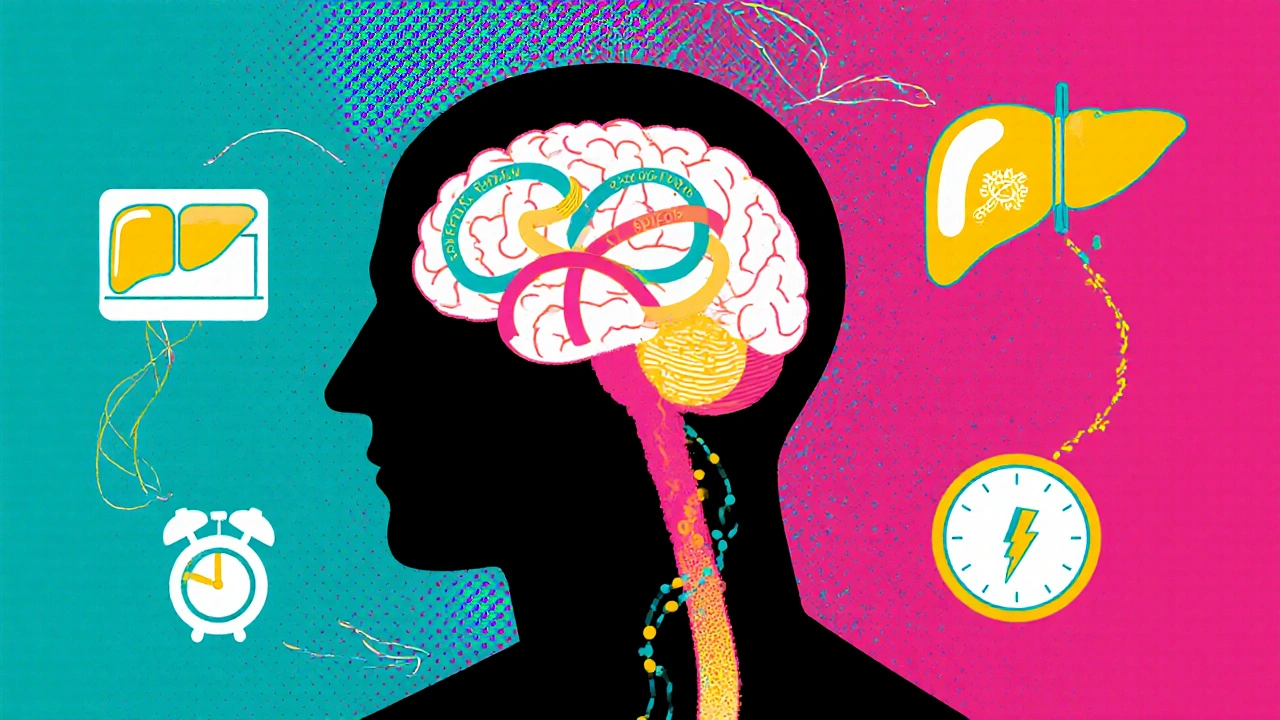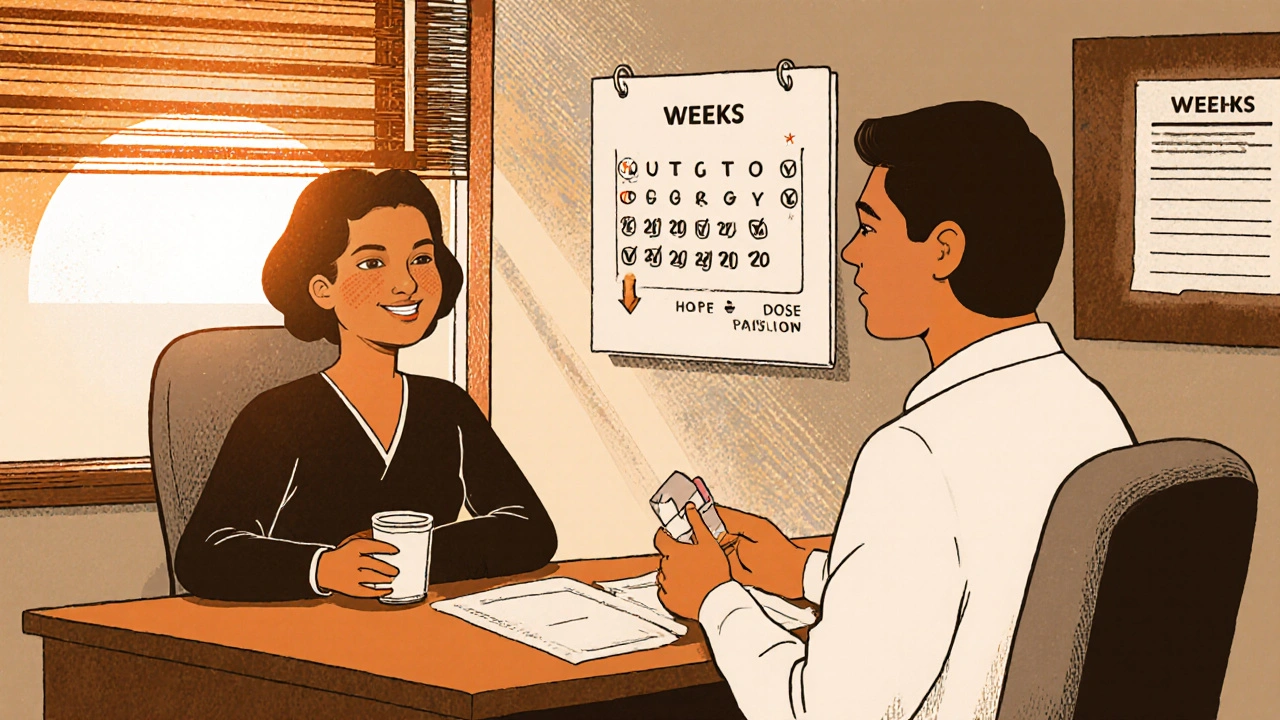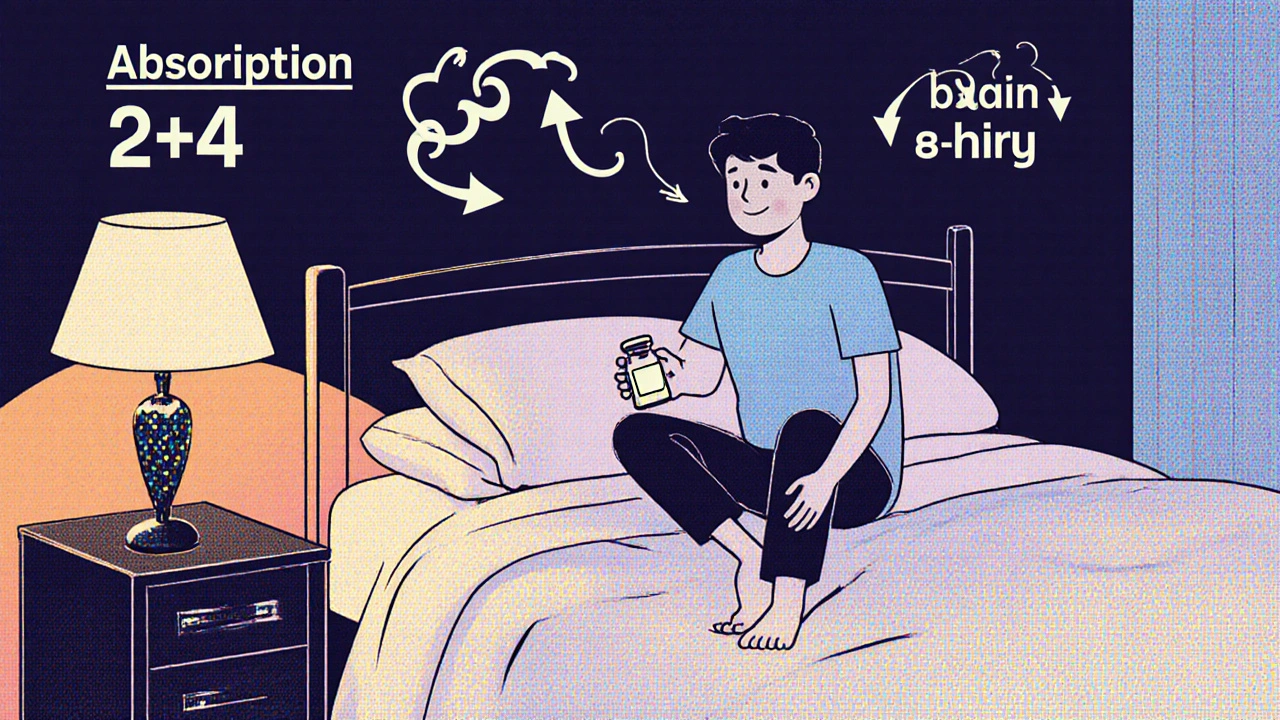Nortriptyline Onset Calculator
How Soon Will You Feel Improvement?
Select the condition you're treating to estimate when you might start seeing benefits from nortriptyline.
Quick Takeaways
- Most people notice mood improvement within 2‑4 weeks, but full benefits can take 6‑8 weeks.
- Pain relief often starts earlier - around 1‑2 weeks for neuropathic pain.
- Starting dose and individual metabolism (especially CYP2D6 activity) heavily influence the timeline.
- Steady therapeutic plasma levels usually appear after 5‑7 days of consistent dosing.
- Patience and proper follow‑up with your clinician are key to a successful outcome.
When you take Nortriptyline is a tricyclic antidepressant (TCA) prescribed for depression and certain types of nerve pain, you’ll naturally wonder how quickly it will start helping. The answer isn’t a one‑size‑fits‑all number; it depends on dosage, the condition you’re treating, your body’s metabolism, and how strictly you stick to the regimen. Below we’ll break down the typical timelines, the science behind them, and practical tips to keep the process as smooth as possible.
What Kind of Drug Is Nortriptyline?
Nortriptyline belongs to the Tricyclic antidepressant family. It works by increasing the levels of two neurotransmitters - serotonin and norepinephrine - in the brain. Those chemicals help regulate mood, pain perception, and sleep. Because it hits both pathways, nortriptyline can treat both mood disorders (like Depression) and neuropathic conditions such as diabetic neuropathy or post‑herpetic neuralgia.
The Pharmacokinetic Timeline: When Does the Drug Hit Your Blood?
Understanding how the body processes nortriptyline helps explain the onset patterns.
- Absorption: After an oral dose, the drug is absorbed within 2‑4 hours. Food can slow this a bit, but it doesn’t change the overall effectiveness.
- Distribution: It quickly crosses the blood‑brain barrier, reaching the central nervous system in roughly 6‑8 hours.
- Metabolism: The liver enzyme CYP2D6 is the main workhorse breaking down nortriptyline. People who are "poor metabolizers" may feel effects sooner and also experience stronger side‑effects, while "ultra‑rapid metabolizers" might need a higher dose to see benefit.
- Steady‑state plasma level: It takes about 5‑7 days of regular dosing for blood levels to plateau. This is the point where you can start evaluating true clinical response.
Typical Onset for Different Indications
Because nortriptyline treats multiple conditions, the timeline varies.
- Depression: Most clinicians expect a noticeable lift in mood after 2‑4 weeks, with full antidepressant effect often emerging between 6‑8 weeks.
- Neuropathic Pain: Pain relief can appear faster - many patients report reduced discomfort within 7‑14 days, sometimes as early as a few days.
- Sleep Improvement: If you’re taking it for insomnia, the sedating effect may be evident the first night, but the sleep‑quality benefit stabilizes after about 2 weeks.
Dosage Matters: Starting Low, Going Slow
Doctors typically begin with a low dose (often 10‑25 mg at night) to gauge tolerance. The dose is then increased by 10‑25 mg every week or two. Here’s why the titration schedule influences onset:
- Low initial dose: Limits early side‑effects like dry mouth, dizziness, or constipation, helping you stay on the medication long enough to reach therapeutic levels.
- Gradual increase: Allows the Therapeutic plasma level to rise without overwhelming the system.
When you finally settle at a maintenance dose (usually 75‑150 mg daily for depression, up to 200 mg for pain), you’ll be in the sweet spot where benefits become most apparent.
Factors That Can Speed Up or Slow Down the Response
Several personal and medical variables affect how quickly you’ll feel better.
| Factor | How It Impacts Onset |
|---|---|
| Age | Older adults metabolize slower, potentially extending the time to steady state. |
| Body weight | Higher body mass may require a slightly higher dose for the same effect. |
| CYP2D6 genotype | ‘Poor metabolizers’ feel effects sooner but risk side‑effects; ‘ultra‑rapid’ may need more dose. |
| Concurrent medications | Drugs that inhibit CYP2D6 (e.g., fluoxetine) can raise nortriptyline levels, speeding onset but also side‑effects. |
| Lifestyle factors | Regular sleep, balanced diet, and avoiding alcohol help maintain stable plasma levels. |

Side Effects: What to Expect in the Early Weeks
Typical early‑stage side effects include dry mouth, blurred vision, constipation, and mild dizziness. Most of these fade within the first 2‑3 weeks as your body adjusts. If you notice:
- Severe heart palpitations
- Marked mood worsening or suicidal thoughts
- Uncontrollable tremors
you should contact your healthcare provider immediately. These could signal an adverse reaction or the need for dose adjustment.
When to Call Your Doctor
Even though patience is a virtue with antidepressants, there are clear red flags indicating a need for professional input.
- No improvement after 4 weeks: You may need a dose increase or a medication switch.
- Intense side effects persisting beyond 3 weeks: Adjustments or supportive treatments might be required.
- Sudden mood swings or suicidal thoughts: Seek help right away, regardless of timeline.
Comparing Nortriptyline with Other Common Antidepressants
| Medication | Typical Onset (mood) | Common Dose Range | Primary Uses | Metabolism Pathway |
|---|---|---|---|---|
| Nortriptyline | 2‑4 weeks (up to 8 weeks for full effect) | 75‑150 mg daily | Depression, Neuropathic pain | CYP2D6 |
| Amitriptyline | 2‑3 weeks | 75‑150 mg daily | Depression, Migraine prophylaxis | CYP2D6, CYP1A2 |
| Sertraline (SSRI) | 4‑6 weeks | 50‑200 mg daily | Depression, Anxiety, PTSD | CYP2C19, CYP3A4 |
Notice how TCAs like nortriptyline usually show mood improvement a bit earlier than many SSRIs, but they also carry a higher side‑effect profile. That trade‑off is why clinicians match the drug to a patient’s specific situation.
Tips to Optimize the Onset Experience
- Take it at the same time each night: Consistency speeds up reaching steady‑state levels.
- Don’t skip doses: Missing a night can reset the accumulation curve, delaying benefits.
- Monitor blood pressure: TCAs can affect heart rhythm, especially in older adults.
- Stay hydrated and chew sugar‑free gum: Helps combat dry mouth.
- Pair with therapy: Combining medication with cognitive‑behavioral therapy often halves the time to noticeable improvement.
What Happens If You Stop Too Early?
Stopping abruptly can cause withdrawal‑like symptoms - dizziness, nausea, and flu‑like feelings. If you’re thinking of coming off, taper the dose over 2‑4 weeks under medical supervision. A gradual taper also gives your brain time to rebalance neurotransmitter levels, reducing the chance of a relapse.

Bottom Line
For most patients, how long does nortriptyline take to work? translates to a few weeks for the first signs of relief and up to two months for the maximum benefit. Patience, proper dosing, and regular check‑ins with your prescriber are the three pillars that turn a good medication into real, lasting improvement.
How soon can I expect mood improvement?
Most people notice a subtle lift after 2‑4 weeks, but full antidepressant effects often require 6‑8 weeks of consistent dosing.
Will I feel pain relief faster than mood improvement?
Yes. For neuropathic pain, many patients report reduced discomfort within 7‑14 days, sometimes even before mood changes appear.
What if I’m a poor metabolizer of CYP2D6?
You may reach therapeutic levels faster, but you’re also at higher risk for side effects. Your doctor might start you on a lower dose and watch blood levels closely.
Can I take nortriptyline with other antidepressants?
Combining TCAs with other serotonergic drugs can increase the risk of serotonin syndrome. Always discuss any medication changes with your clinician.
How do I taper off nortriptyline safely?
A typical taper reduces the dose by 10‑25 mg every 1‑2 weeks, depending on how you feel. Your doctor will create a personalized schedule to avoid withdrawal symptoms.


Comments
Charlie Stillwell
Bottom line: this write‑up is a sloppy mash of pharmacokinetic jargon and feel‑good fluff. It drags out the CYP2D6 discussion like it’s a thriller, but the practical takeaways get lost in the noise. If you’re hunting for a clear titration schedule, you’ll have to wade through a sea of buzzwords. 🚀💊
October 20, 2025 AT 21:01
Ken Dany Poquiz Bocanegra
Fair point, but the core advice-steady dosing, watch side‑effects, give it weeks-still holds up.
October 20, 2025 AT 21:34
krishna chegireddy
Honestly, this whole “wait 6‑8 weeks” mantra is a pharma‑engineered delay to keep us hooked on their endless refill cycle. They want you to believe the drug’s magic is slow, while the real culprit is the hidden agenda of profit.
October 20, 2025 AT 22:41
Tamara Schäfer
i get why some folks think that, but thare's actual clinical data showing the average onset is 2‑4 weeks for mood and 1‑2 weeks for pain. staying patient and keeping a log can really help you see the real pattern.
October 20, 2025 AT 23:47
Tamara Tioran-Harrison
Indeed, one might as well sip tea while waiting for miracles.
October 21, 2025 AT 00:54
kevin burton
When you start nortriptyline, the first thing to keep in mind is that the drug follows a classic tricyclic pharmacokinetic curve.
Absorption peaks within a few hours, but the real therapeutic steady state doesn’t show up until about a week of consistent dosing.
That’s why doctors often tell you to give it at least five to seven days before judging any effect.
The modest improvement in sleep you might notice the first night is usually just the sedating side‑effect, not a true antidepressant response.
True mood elevation typically requires two to four weeks of daily dosing, and you may not see the full benefit until six to eight weeks.
If you’re using the medication for neuropathic pain, you’re in luck because the analgesic effect tends to appear sooner, often within ten to fourteen days.
Dosage matters a lot; starting low-say ten milligrams at bedtime-helps you avoid the classic anticholinergic side‑effects like dry mouth and constipation.
Then the clinician will usually bump the dose by ten to twenty milligrams every one to two weeks, watching your tolerance closely.
People who are poor metabolizers of CYP2D6 will reach higher plasma levels faster, so they may need a lower target dose to stay comfortable.
Conversely, ultra‑rapid metabolizers might require higher doses or even a different medication because the drug clears too quickly for a steady effect.
Regular blood pressure checks are advisable, especially in older adults, because tricyclics can affect cardiac conduction.
Keeping a simple daily diary of mood, pain scores, sleep quality, and any side‑effects can give you and your prescriber concrete data to guide adjustments.
Don’t skip doses; missing a night resets the accumulation curve and can make the timeline feel longer than it actually is.
If you experience severe side‑effects-like palpitations, worsening depression, or suicidal thoughts-call your provider immediately.
When you finally reach the maintenance dose, most patients report a stable improvement that lasts as long as the medication is continued.
Finally, tapering off should be done gradually over several weeks to avoid withdrawal symptoms such as nausea, dizziness, or flu‑like malaise.
October 21, 2025 AT 04:47
Max Lilleyman
Good rundown, but remember to check for drug interactions-mixing TCAs with SSRIs can be dangerous. ⚠️
October 21, 2025 AT 08:41